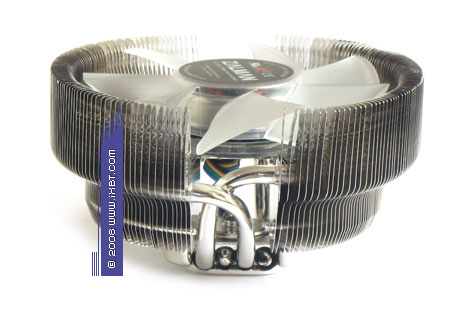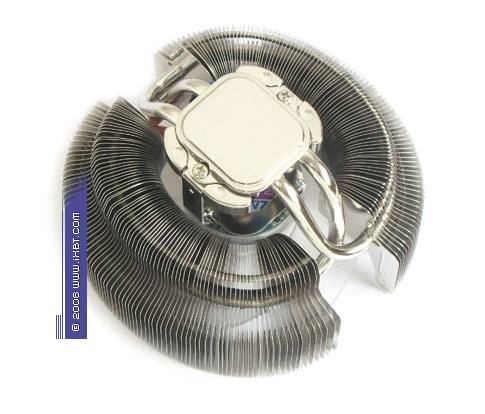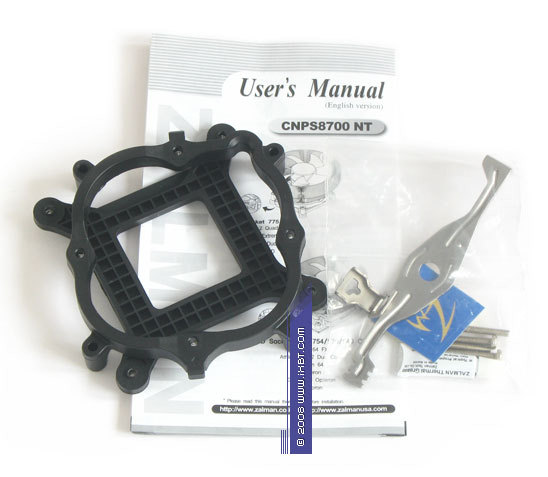Zalman CNPS8700 NT
This high-end product has a peculiar look, different from all other coolers -- along with an imposing all-copper design comprising a base (40 x 35 x 5 mm), two heat pipes (6 mm in diameter), and two radial fin-stacks (122 x 50 mm), this cooler also features bright finish (all functional surfaces are nickel-plated) and a nice fan with an open impeller (110 x 110 x 25 mm), spiced up with blue LEDs, traditional for modded products.
The main feature of the CNPS8700 NT is its dense two-stack finning (86 fins in each stack) with developed heat exchange surface area for a compact heat sink (3300 cm2 -- almost a record-breaking value). The on-board fan also produces a good impression. It offers balanced parameters both in aerodynamic design (optimized impeller) and electromechanics (neat electric fitting of the engine plus double ball bearing of good quality), trying to conform with High-End requirements.

We should also mention a special bowl-shaped configuration of finning, which usage is justified in the CNPS8700 NT: as is well known, the main drawback of an open impeller (that is a fan working as a propeller) is a weak flow characteristic (low static pressure and resulting air flow speed). But if such a fan is install inside radial finning, an open impeller may be used to advantage. Our cooler under review is based on this idea -- pronounced turbulent streams at the fan edge blow through outer edges of fins and contribute to ventilation of inner parts of the finning, providing better heat exchange between pipes and fins. So we have all reasons to assume that modifications of thermal ideology used in Zalman CNPS7000 and CNPS7700 must do only good to the CNPS8700 NT.

Meanwhile, configuration of this cooler still has some minor but irritating problems. First of all, fin placement is too dense -- the average fin step is no more than 2 mm even at the outer perimeter, and it narrows down to 0.5 mm inside the bowl (directly under the "work field" of the fan). Whatever you may say, this clutter seriously hampers ventilation of the heat sink and practically cancels advantages of interaction between an open fan and the finned bowl. Another sin of this cooler is nonoptimal distribution of heat pipes -- their joints with the fins are too close to the fan, while the bottom edge of the fins is too far from points of thermal contact and does not participate in heat exchange. Frankly speaking, we expected Zalman engineers to be more careful with thermal details -- they are too experienced to make such mistakes.

By the way, usability of the CNPS8700 NT is not peachy either: installation procedures for the AMD platform are quite simple (the bundle includes a special mounting frame to fix the cooler in a socket), but the Intel platform is not that friendly, and a screwdriver becomes of prime necessity. All operations will take much time and effort -- you'll have to remove a motherboard from an enclosure, install a mounting plate for LGA775, and only then install the cooler in a socket.
As a result, technical image of this cooler is somewhat confused -- on one hand, we have aesthetic design and generally good thermal parameters; on the other hand, configuration problems and mediocre usability. This is not enough to cross the CNPS8700 NT out of the High-End list. But we still feel pessimistic about its functionality.
Well, we've cleared up questions of technical design and usability issues, there is no need to elaborate. It's time to address the main aspect of our article -- test results of Cooler Master V4, Scythe Shuriken, and Zalman CNPS8700 NT.
Write a comment below. No registration needed!






